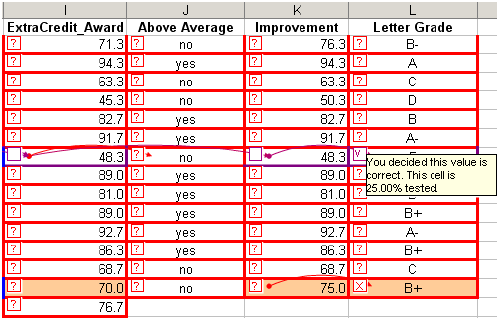Authors
Margaret Burnett, Marc Fisher, & Gregg Rothermel
Abstract
Spreadsheets are one of the most commonly used end-user programming environments. As such, there has been significant effort on the part of researchers and practitioners to develop methodologies and tools to improve the dependability of spreadsheets.
Our work has focused on the development of the "What You See Is What You Test" (WYSIWYT) family of techniques. WYSIWYT is designed to be seamlessly integrated into a spreadsheet environment and the user’s development processes. It uses visual devices that are integrated into the user’s spreadsheet to guide the process of finding and fixing problems with the spreadsheet.
There are three major components to the WYSIWYT methodology:
- A testing and debugging methodology.
- An assertions mechanism.
- The "Surprise-Explain-Reward" strategy.
Sample

WYSIWYT provides a testing and debugging methodology.
As the user edits their spreadsheet they are provided with visual devices indicating the "testedness" of the cells and the spreadsheet and the ability to mark the values in cells as correct or incorrect.
If the user marks a cell's value as correct, the testedness of the contributing cells is updated as is the testedness of the spreadsheet.
If, instead, the user marks a cell's value as incorrect, additional information is displayed to the user about the "fault likelihood" of cells based on the number of correct and incorrect values to which they contribute.
Publication
2007, Dagstuhl Seminar, End-User Software Engineering
